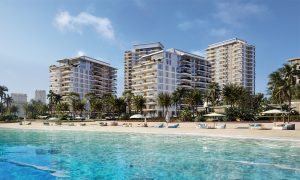Where are the towers?
Dubai’s stranglehold on the world’s supply of cranes has now been consigned to legend, but it leaves the question – where did the cranes go?

Dubai’s stranglehold on the world’s supply of cranes has now been consigned to legend, but it leaves the question – where did the cranes go?
When Dubai boomed, the crane became a symbol of its extraordinary growth. Scaling higher, in more numbers and faster than anyone could remember, the sight of cranes swaying above the city building its mini cities bewildered the watching world.
Along the elongated Sheikh Zayed Road, a financial district grew, as did the world’s tallest tower at its end. Towards the other, developments like the Palm, Marina and JLT were seemingly being lifted out of the ground by cranes at high speed, providing housing for hundreds of thousands. Whether it was a third of the world’s cranes or just quarter, the truth was that for a brief moment of time Dubai was the tower crane’s temporary home.
At the same time inventories and orders boomed. The long pipeline seemed so long, nobody bothered to wonder whether it could ever end.
Of course, we know now that it did come to an abrupt and painful end. The Dubai on the blueprints and tender sheets was not the same Dubai that was drying up in the sun. People weren’t arriving to fill the new houses and apartments.
The big developers like Emaar and Nakheel pulled funding from their projects and as the construction plans were reeled in the cranes began to stall and by 2008 had almost stopped altogether.
Come to 2012, and things are beginning to improve. Research specialist Ventures Middle East predicts construction contracts will rise by 25% in 2012 and MEED estimates that the UAE has the highest level of construction activity per capita in the world. But even if all the work started to tomorrow, it would be at least a year before most would see cranes working. There is also a great deal of cynicism to overcome and the scars all too easy to see.
Having disentangled itself over many issues regarding ownership and financing, Nakheel admitted defeat on Dubai Waterfront, one of its flagship developments in January. The drawings and models were spectacular, with canals and man-made islands creating a metropolis for over a million people in an area twice the size of Hong Kong. The cranes bought to build it have now been sold.
Riding high on the success of the Palm, the cranes would have built the dense clutch of skyscrapers carving the 139 million sqm of marinas, canals and parks. But now, the developer of the Palm has decided to place the 13 cranes up for sale for $272,000 each. “Some of the tower cranes are partially erected and remain stocked in unopened boxes as delivered by the manufacturer,” an advertisement promoting the sale said.
The short sharp shock of Dubai has had a dramatic but ultimately healthy effect on the local crane suppliers.
Local crane representatives now have a radically different approach to how they are doing business. The sudden fall off of business meant many of them had to work hard with their OEM partners to re-deploy their equipment.
Some like Potain and Manitowoc dealer NFT have looked much further afield than perhaps they would have done in the past. NFT, for instance, has in the past few years shipped as far as Singapore and Azerbaijian. It has also turned to Saudi Arabia for revenue. The Kingdom is familiar territory to CEO Nabil al Zalawhi, who started the operation there in the 1980s. As Dubai faltered projects such as the Princess Nora University proved fruitful new ground for its fleet, taking on dozens of cranes.
Wolffkran tower cranes have also found the resilient Saudi Arabian market to be a desirable location in the downturn. It recently supplied cranes to the Mekkah Clock Tower development but perhaps its most significant move for its long term success in the region has been its unique relationship with local player Kanoo Machinery Group.
Since forming a joint-venture in 2007, the two companies have taken the radical move of moving from a selling business to a rental operation. The newly re-shaped company scored a major coup last year by penning a five-year deal with Habtoor Leighton Group to supply, install and dispose of existing equipment and plant.
The first part of the arrangement saw the company supply five cranes and the removal of old stock from the Mafraq Hospital on the outskirts of Abu Dhabi. Going forward the arrangement sees Wolffkran Arabia first option on future projects.Budgets are beginning to loosen up in the UAE once more and Wolffkran is currently working on the restarted Burj Residence project in Dubai. As CMME went to press it was revealed that HLG has won the $515 million contract to help build the Habtoor Palace, Las Vegas-style hotel close to the project. It would be easy to envision Wolffkran Arabia moving on to the 25 storey project.
There are other projects beginning to return to life in the country too, especially in Abu Dhabi where since the turn of the year, the government has green-lit projects previously stalled. While Saudi Arabia is the dominant market in the GCC, crane suppliers are accutely aware that Qatar is preparing its own programme of sweeping development. A total of $120 billion will be spent on the World Cup and there are hotels, stadia and infrastructure to built.
The country is currently exploring its options in terms of what exactly will be required but cranes will be essential in scaling the city. The lessons of Dubai will no doubt be foremost in the minds of tasked with supplying them.

























